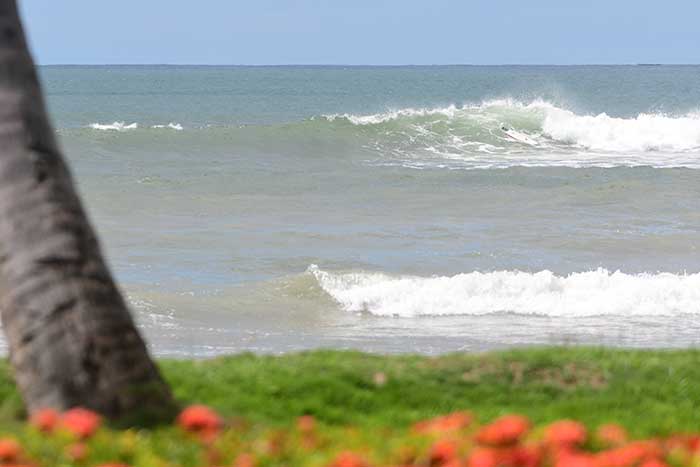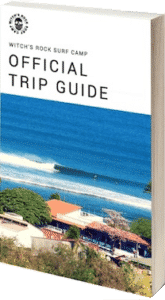
Pico Grande - Playa Tamarindo
Wave Quality: Good (7.5 / 10)
Ideal Swell Direction: SW (215° – 230°) NW (280° – 300°)
Ideal Wave Height: Chest high – overhead
Best Wind Direction: Light offshore
Best Tide: Mid – high
Required Experience: Advanced
Best Board: Shortboard
Bottom: Rock / reef
Crowd: Moderate
Wave Power: (8 / 10)
Best time of the year: July – August
Pico Grande - Playa Tamarindo
Location – Pico Grande is located in the center of Tamarindo, approximately 150 meters south of the Tamarindo Beach Break and breaks just outside of the Pico Pequeño surf spot.
Pico Grande is marked by a lava-thumb reef that jets out into the ocean.
Wave Type / Quality – Right-hand slab ( 7.5 / 10) Good
Pico Grande is Tamarindo’s best right-hand slab wave which can produce a big barrel on the take off followed by 1 or 2 smackable sections. The wave comes out of deep water and then hits a shallow rock / reef which stands the wave up immediately and gurgles on the takeoff. The wave is only about 50 meters long but what it lacks in length, it makes up for in power and speed.
Ideal Swell Direction – SW (215° – 230°) NW (280° – 300°)
Since Pico Grande has a due west orientation, there needs to be a fair amount of west in the corresponding swell. A strong storm that flares up in the South Pacific next to New Zealand or in the central South Pacific will send a healthy dose of SW swell. Pico Grande will also shine on NW swells during the dry season (November – April) when the North Pacific is activated.
Ideal Wave Height – Chest high – overhead
If the swell is any smaller than chest high, Pico Grande will not work. There needs to be a medium – large swell running for the wave to break on the reef. Even when the swell is overhead, the underwater reef will offer consistent shape and a recognizable channel to the immediate south.
Best Wind Direction – Light offshore
Best wind is light – moderate offshore which can range from NNE to NE to ENE. Tamarindo actually has a huge advantage over many other spots to the south because the wind will stay offshore longer. Since Tamarindo is located closer to Lake Nicaragua, the wind will stay offshore here all day while many spots to the south turn onshore around 10am. During the dry season (Dec – April) the offshore winds can be quite strong but the waves generally remain groomed.
Rubber? – Yes (December – April)
Bring some rubber especially if the winds have been blowing offshore for several days. Although rare, water temps can drop down to about 63°F. This is a phenomenon called upwelling. Normally, water temps hover in the 75° – 80°F range. Upwelling really only happens a few times during the dry season. A wetsuit top generally comes in handy for dawn patrol sessions year round.
Best Time To Score? – July – August
July and August are known as Costa Rica’s “Mini-Summer” months where we receive consistent SW swells and offshore winds. This is your best chance of scoring consistent, overhead slabs.

Best Tide – Mid – high
At low tide, you will see how many rocks actually make up the surf spot. As the tide reaches medium levels, the rocks will be almost completely covered and the wave becomes surfable. Granted, you will be dodging boil rocks with medium tides. The ideal tide is about 2 hours before peak high tide.

Required Experience – Advanced
Since the wave breaks over a rock / reef, it is not advised that beginners or intermediates surf here. If you catch the wave at the peak and fall, there is a good chance you will get tumbled into the exposed reef. On good days, you are literally pulling into a slabbing barrel right off the takeoff in front of a large exposed rock.
Best Board – Shortboard
The wave has serious power and a steep drop. A shortboard is generally the best board to make the critical take-off. If you are an experienced longboarder, you could also handle this wave with precaution.

What’s On The Bottom? Rock / reef
What’s The Crowd Like? – Moderate
This spot rarely has more that 10 people on it. But because there is 1 take-off zone, 10 people can seem crowded. If there are plentiful waves coming through, everyone will get their turn and needs to be respectful of the line-up. This wave is quite intimidating and many surfers will opt for an alternative spot.
How powerful is the wave? (8 / 10)
As the only proper slab in Tamarindo, this wave carries great power on the take off. In fact, to catch the wave, you sit on top of a gurgling boil rock which will propel you down the face. Once you’re up and riding, the wave maintains the speed and power through 2 more sections before fading out into deep water
Perfecto Meter – (7.5 / 10) (1 = Lake Michigan wind chop / 10= Kelly Slater Surf Ranch)
On an ideal day with the perfect swell angle, offshore winds, and decent size, the wave can get quite perfect. The reason the rating isn’t higher is because of the short length of the ride.
Spaghetti Arm Index – (4 / 10)
The wave breaks out about 100 meters off the beach but there is a channel the whole way out. When you’re in the rhythm, it is possible to catch wave after wave without even duckdiving.
Hazards – Reef bottom, advanced crowd, dry reef
How Do I Get There?
Pico Grande is about a 2 minute walk south from the Tamarindo Beach Break. This is the first lava rock outcropping you’ll see south of the Tamarindo estuary. You will recognize the wave by large rocks extending out from the shore.
Download the Trip Guide

- See why guests return year after year
- Review all of our surf packages
- Learn what a typical week at surf camp looks like
- How to get here, what to pack, when to travel, and more…

